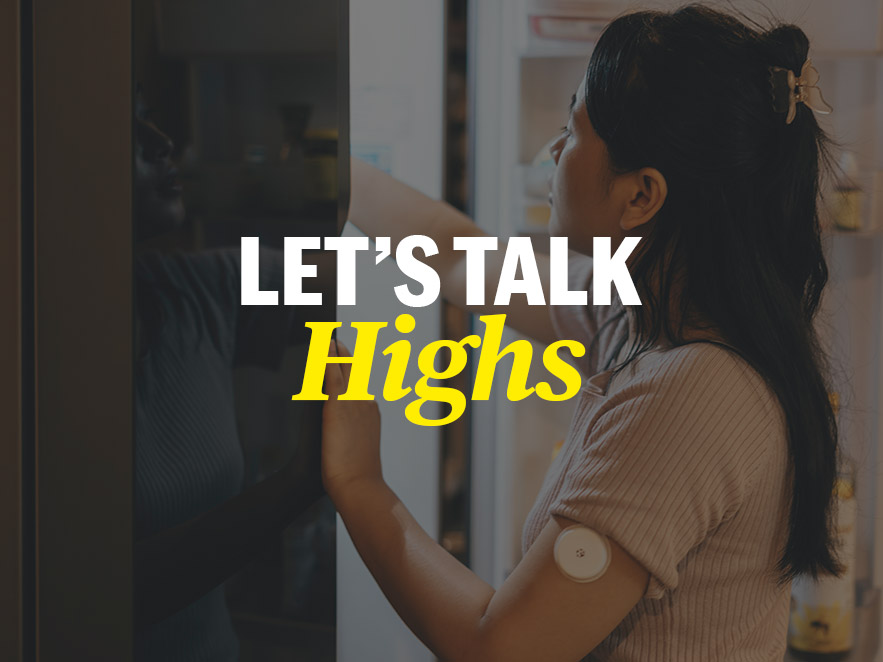Anesthesia
Written by: Beyond Type 1 Editorial Team
9 minute read
January 31, 2019
Anesthesia is scary no matter what—but especially with type 1 diabetes. Before you head to the hospital, consider these anesthesia prep tips.
Glucose Targets in Non-Critically Ill Patients
Glucose targets recommended by the consensus guidelines issued jointly by the American Diabetes Association (ADA) and the American Association of Clinical Endocrinologists (AACE), and separately by the Endocrine Society are shown in Table 1. Higher blood glucose (BG) targets can be set for those who are prone to hypoglycemia, have severe comorbidities, or are terminally ill. However, even then, it is recommended that BG be kept below 11.1 mmol/L200 mg/dl in order to avoid symptomatic hyperglycemia. The basal-bolus insulin doses should be reduced if BG falls below 5.5 mmol/L100 mg/dl, unless the patient is clinically stable and has tight control before admission.
| Table 1. Blood Glucose Targets in Inpatient Setting for Non-Critically Ill Patients According to Joint Consensus of the American Diabetes Association (ADA) and the American Association of Clinical Endocrinologists (AACE) | ||
| Random or Bedtime | Fasting and Pre-meal | Hypoglycemia |
| <10.0 mmol/L180 mg/dl | 5.5-7.8 mmol/L100-140 mg/dl | <3.9 mmol/L70 mg/dl |
Perioperative Diabetes Management
Patients with diabetes should be given preference for early morning surgery. Doing so may decrease risk of hyperglycemia and hypoglycemia resulting from disruption in typical medication and food schedules. On the day prior to surgery, patients with diabetes should continue their usual hospital ordered calorie-restricted, carbohydrate-consistent diabetic diet along with their ordered insulin and/or oral antihyperglycemic medications. Changes that need to be made to the patient’s diabetes medication regimen are listed in table 2. Patient’s healthcare team needs to ensure that patient is not sent to the pre-anesthesia unit without receiving their adjusted scheduled dose of long-acting or intermediate acting insulin. This is especially important in patients with type 1 diabetes who are traditionally at higher risk of diabetic ketoacidosis if insulin regimen is disrupted.
| Table 2. Preoperative Diabetes Management Night before or Morning of Surgery |
| Diabetes Medication Management |
| · Long-acting (glargine or detemir) insulin: Inject 80 percent of scheduled dose at bedtime or in the morning before surgery depending on the patient’s usual administration time. |
| · Intermediate acting (NPH) insulin: Inject ½ of usual dose |
| · Rapid (aspart, lispro, glulisine) or short-acting (regular) Insulin: Omit morning dose (including inhaled insulin) |
| · Pre-mixed insulin (70/30, 75/25, 50/50): Inject ½ of the NPH component of the usual premixed insulin and no rapid or short-acting insulin on the morning of surgery. |
| · Oral and non-insulin injectable diabetes medications: Discontinue on the morning of surgery9 |
| Blood Glucose Monitoring
|
| · Check blood glucose at bedtime and on the morning of surgery, and every four to six hours thereafter
· If hypoglycemic at bedtime or overnight, patient should be treated with glucose gel and not by juice. |
Intraoperative: Upon arrival to the pre-anesthesia, diabetes management is largely dependent on patient’s type of diabetes, blood glucose upon arrival, and the type of surgery. Target blood glucose range in the perioperative period is 4.4-10.0 mmol/L80-180 mg/dl. Tighter perioperative glycemic control does not improve outcomes and has been associated with hypoglycemia.
Minor Surgeries: Patient’s blood glucose upon arrival to the pre-anesthesia unit can determine treatment and BG monitoring frequency as outlined in table 3. Patients who have a blood glucose level > 10.0 mmol/L180 mg/dl and are not responding to subcutaneous insulin within an hour can be started on IV insulin infusion. On the other hand, patients with blood glucose lower than 5.5 mmol/L100 mg/dl, should be started on IV dextrose infusion as outlined in table 3. All other patients should receive maintenance intravenous fluids that do not contain dextrose such as lactated ringers, normal saline, or 0.45% normal saline.
Major Surgeries: It is recommended that IV insulin infusion be started for patients undergoing chest, abdominal cavity, vascular bypass, transplant, spinal or brain surgery, total hip or knee replacement surgeries, or a surgery anticipated to last longer than four hours. For patients who are started on IV insulin infusion, a dextrose containing intravenous fluid is necessary. D5W at 40 ml/hr or D10W at 20 ml/hr should be started to provide approximately 50gm of glucose over 24 hours.
| Table 3. Intra-operative Diabetes Management for Non-Major Surgery | |||
| BG <4.4 mmol/L80 mg/dl
Give at least Check BG in 15-30 min. |
BG 4.4-5.5 mmol/L80-100 mg/dl
Begin D5W at Check BG in one hour Check BG in one hr |
BG 5.5-10.0 mmol/L100-180 mg/dl
Continue to monitor
|
BG >10.0 mmol/L180 mg/dl
Give Corrective Rapid-acting Insulin q4hrs (table 3) or start Insulin infusion, check BG every hour
|
Postoperative: While patient is in the post-anesthesia unit, management and frequency of BG monitoring remains similar to during surgery (table 3). If patient’s BG is greater than 10.0 mmol/L180 mg/dl, blood glucose should be checked hourly. Corrective dose of rapid acting insulin should be administered every four hours. Upon arrival to the regular floor, it is recommended to start basal plus nutritional, or basal plus corrective rapid-acting insulin regimen. If patient is not eating, nutritional insulin should be held. It may start later at reduced doses based oral nutrition intake. Patients who are status post cardiac surgery should continue on IV insulin infusion.
Insulin Pump Management in the Hospital
Approximately 30-40 percent of type 1 diabetes patients and an increasing number of insulin requiring type 2 patients are using insulin pumps. Majority of insulin pump users are well-trained on diabetes self-management and frequently get frustrated when they are asked to stop using their insulin pump during hospitalization. Adding to this frustration is the non-intentional delay in administering their bolus or corrective insulin by hospital staff. It is recommended that insulin pump users be allowed to self manage their diabetes during hospital provided if they are able to demonstrate adequate skill and ability to manage their pumps and are able to procure their pump supplies. An “insulin pump agreement” helps outlines expectations that patient needs to collaborate and communicate with hospital team by reporting blood glucose and basal levels, and any boluses given for meals or correction. These values need to be documented on a special “Insulin pump record sheet.”
In the event of surgery: Patients who are on an insulin pump can continue their usual basal rate during minor surgeries and major non-cardiac surgeries lasting less than six hours, providing that their ongoing basal rate is not causing hypoglycemia. If there is any concern about possible fasting hypoglycemia, a temporary basal rate should be set at 80 percent of the patient’s usual basal rate. The infusion set should be changed 24 hours before surgery and insertion site should be selected away from the surgical site. The chosen site can be anywhere on the upper outer thighs, upper arms, or abdomen 2 inches away from the umbilicus. Blood glucose should be checked every hour during surgery. Transition to insulin infusion should be considered if blood glucose exceeds and remains above 10.0 mmol/L180 mg/dl.
Critical Illness: Patients on insulin pumps need to be transitioned to an intravenous insulin infusion in critical illness.
Hypoglycemia
Treatment depends on severity of hypoglycemic episode, and whether or not patient is conscious. The hypoglycemia management guidelines by Joslin Diabetes Center are listed in Table 4. Recurrence of hypoglycemia is common. Failing to adjust insulin regimen after a hypoglycemic event is common and is a strong predictor of recurrence of hypoglycemia and declining renal function. Therefore, it is important for treating provider to review patient’s insulin regimen and adjust basal or corrective bed-time insulin doses in the event of fasting hypoglycemia, or bolus and/or corrective insulin doses in the event of postprandial hypoglycemia. In about 20 percent of cases, rebound hyperglycemia is experienced after a hypoglycemic event. Close communication between physicians and nursing staff prior to making any changes to patient’s insulin regimen is quite important. Over-correction with carbohydrates is frequently the main cause of rebound hyperglycemia. For example, giving no more than 20 gm of carbohydrate for correction of blood glucose between 2.8-3.9 mmol/L50-70 mg/dl and calculating D50 dose based on blood glucose reading at the time of hypoglycemic episode instead of injecting full ampule are good practice. Examples and serving sizes of simple carbohydrates used to treat hypoglycemia are listed in Box 1. It needs to be noted that patients with gastroparesis should receive treatment with glucose gel due to their delayed gastrointenstinal absorption. Blood glucose should be checked 15 minutes later and if blood glucose remains <3.9 mmol/L70 mg/dl, another 15 gm of simple carbohydrates should be given. As discussed in the previous section, for critically ill patients the consensus bar for hypoglycemia is considered 5.5 mmol/L100 mg/dl.
| Table 4. Hypoglycemia Management (Non-critically ill Patients) | ||
| Treatment | ||
| Conscious on Oral Feeding | BG: 2.8-3.8 mmol/L50-69 mg/dl | 15-20 grams of simple carbs |
| BG < 2.8 mmol/L50 mg/dl | 20-30 grams of simple carbs | |
| Conscious but NPO | On IV insulin | · Stop insulin infusion
· Inject bolus dose D50W IV. Dose in ml = (100-BG) x 0.4 · Start D10W IV at 25 cc/hr · Once BG is back to >5.5 mmol/L100 mg/dl, stop D10W and resume insulin infusion at 50 percent of the previous rate |
| On SC insulin | · Inject bolus dose D50W Dose in ml = (100-BG) x 0.4
· Start D10W IV at 25cc/hr · Once BG is back to >5.5 mmol/L100 mg/dl, stop D10W and resume insulin regimen after appropriate adjustments are made
|
|
| Unconscious | No IV access | · Give 1 mg glucagon IM or 0.5 mg for patients <50 kg body weight
· Once IV access is established, proceed with steps outlined for conscious patient |
| Insulin Adjustment | ||
| Fasting hypoglycemia | · Reduce long-acting basal insulin by 20 percent if BG is 2.8-3.9 mmol/L50-70 mg/dl
· Reduce long-acting basal insulin by 30 percent if BG is < 2.8 mmol/L50 mg/dl · If patient received corrective insulin prior to the event, consider increasing sensitivity factor (SF) of corrective insulin |
|
| Postprandial
hypoglycemia |
· Reduce bolus (nutritional) insulin by 20-50 percent for the duration that patient’s oral food intake is below baseline
· If patient had received corrective insulin prior to the event, consider increasing sensitivity factor (SF) of corrective insulin |
|
| Box 1. Examples of 15 grams of carbohydrate |
| · Four glucose tablets
· One tube glucose gel · 4 oz (1/2 cup of juice or regular soda) · 4 teaspoons of sugar |

Author
Beyond Type 1 Editorial Team
Beyond Type 1 is the largest diabetes org online, funding advocacy, education and cure research. Find industry news, inspirational stories and practical help. Join the 1M+ strong community and discover what it means to #LiveBeyond a diabetes diagnosis.
Related Resources

Curious about how to join a diabetes clinical trial? If so, good on ya’, because...
Read more

Diabetes clinical trials pave the way for how we manage and treat type 1 and...
Read more

Think of clinical trials as a treasure hunt! Doctors need brave explorers like you from...
Read more

